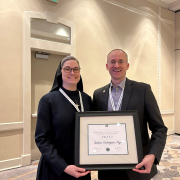Why all the Fuss Over Porn?
Last month, I raised the problem of shamelessness and how, in the face of concupiscence, a healthy sense of shame is essential in preserving the dignity of the human body and sexuality. Attitudes and behavior marked by shamelessness lead to an exaggerated emphasis on the sexual features of the human body and strips away the personal meaning of human sexuality. Shamelessness reduces the human person to a mere object to be used and discarded by others and even a commodity to be bought and sold. Pornography is the most prominent example of shamelessness today.
Some wonder why we Catholics make such a fuss over porn. The Church does indeed make quite a fuss over pornography. As I explained in my previous article, the Catechism identifies the making, distributing, and consumption of pornography as grave sins. It even goes so far as to implore civil governments to outlaw pornography. So, why all the fuss? I believe contemporary social science research can shed some light on why everyone should be quite concerned about pornography. In short, recent research has made it increasingly clear that pornography is omnipresent, toxic to the human person, and addictive. Let’s look at the first of these.
With the proliferation of the Internet, smartphones, and wireless technologies, it has become possible to access pornography anywhere, anytime. Whereas previous generations had to go to a store and purchase pornographic materials from a vendor, now anyone can find it at any moment in virtual privacy. These technologies and the accessibility they provide have allowed the porn industry to grow into a multi-billion dollar industry. According to a 2009 article in the Journal of Economic Perspectives, the US “adult entertainment” industry produces more revenue than any of the major professional sports leagues (e.g., NFL, MLB, NBA, etc.).1 The anti-porn advocacy group “Fight the New Drug” reports that one of the most popular pornographic websites on the Internet had 42 billion visits to their site in calendar year 2019. That’s an average of 115 million visits per day. In that same year, 1.36 million hours of new pornographic content was uploaded to the site. If one were to try to watch all the pornographic material uploaded to this site in 2019 alone, it would take 169 years of continuous viewing!2
Bearing in mind the toxic effects of pornography and its addictive nature, which I will discuss next month, these prevalence numbers are absolutely staggering and should give every concerned adult pause. Research tells us that most females and nearly all males have consumed some amount of Internet pornography prior to turning 18. For these unfortunate young people, most have their first exposure during the middle school years. This coincides with the time when many of these children receive their first cell phone or other portable, Internet-capable devices. Sadly, many, many parents do not take necessary precautions such as enabling parental controls and installing filtering and accountability software when giving their children such devices.3 Parents are also often ill-equipped and hesitant to talk with their children about pornography, its destructive effects, and how to avoid it.4 Clearly, there is much work to do here for all of us (parents, educators, ministers, mental health professionals, etc.) if we are to build a culture of purity in which the dignity of the human person is upheld and the hearts of our young are supported on the paths of virtue and chastity.
_________________________
[1] Edelman, B. (2009). Red light states: Who buys online adult entertainment? Journal of Economic Perspectives, 23, 209-220.
[2] See https://fightthenewdrug.org/2019-pornhub-annual-report/
[3] See https://protectyoungeyes.com for guidance.
[4] See www.defendyoungminds.com for helpful resources, especially the book Good Pictures, Bad Pictures.
Note: This article is part of a series of reflections on Pope St. John Paul II’s “Theology of the Body.”
Continue Reading: The Toxic Nature of Porn

Written by, Dr. Andrew Sodergren, M.T.S., Psy.D.,
Director of Ruah Woods Psychological Services
(Article originally published in The Catholic Telegraph, June 2023 Issue, the official magazine of the Archdiocese of Cincinnati)











